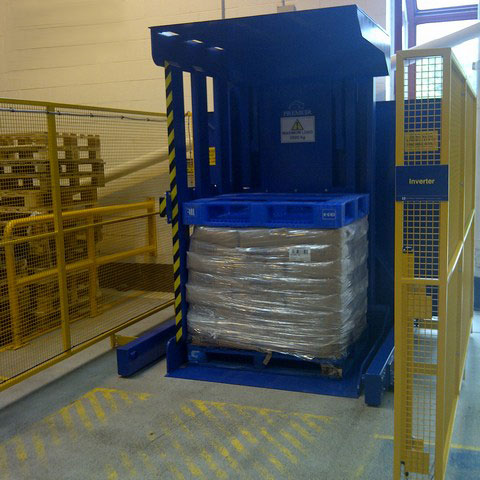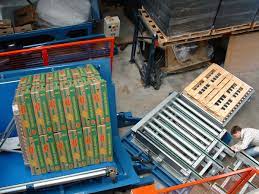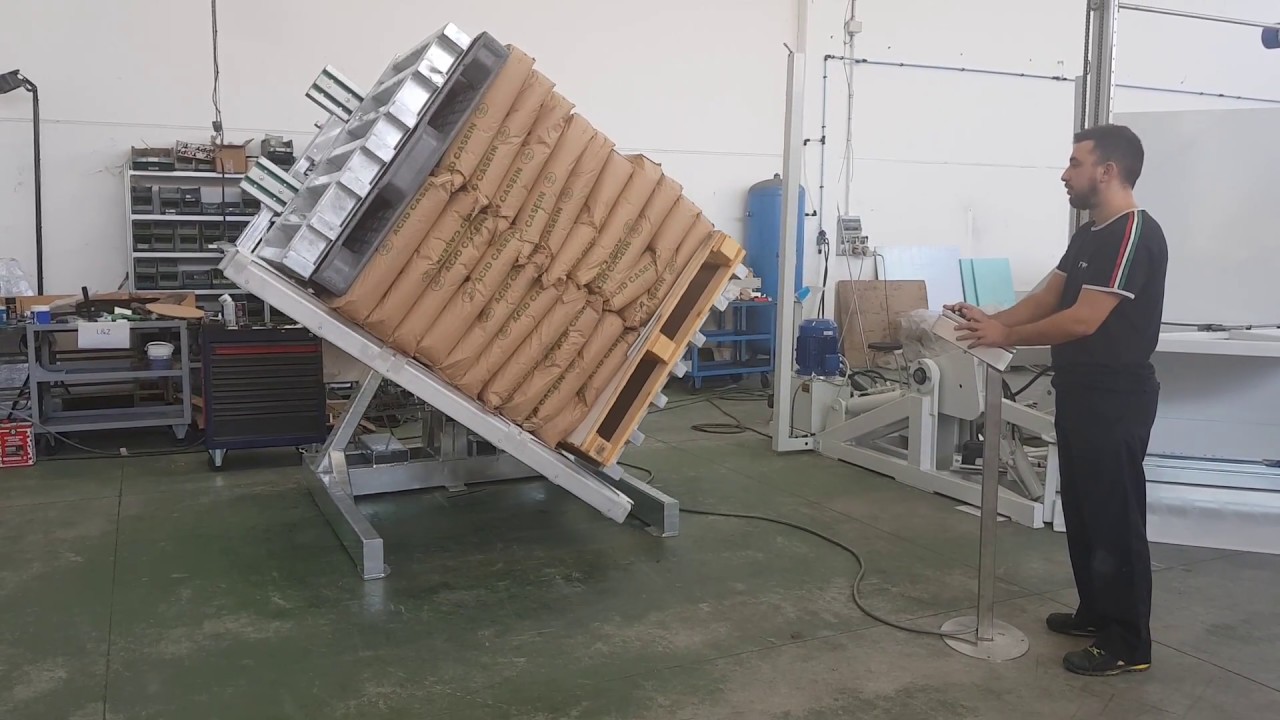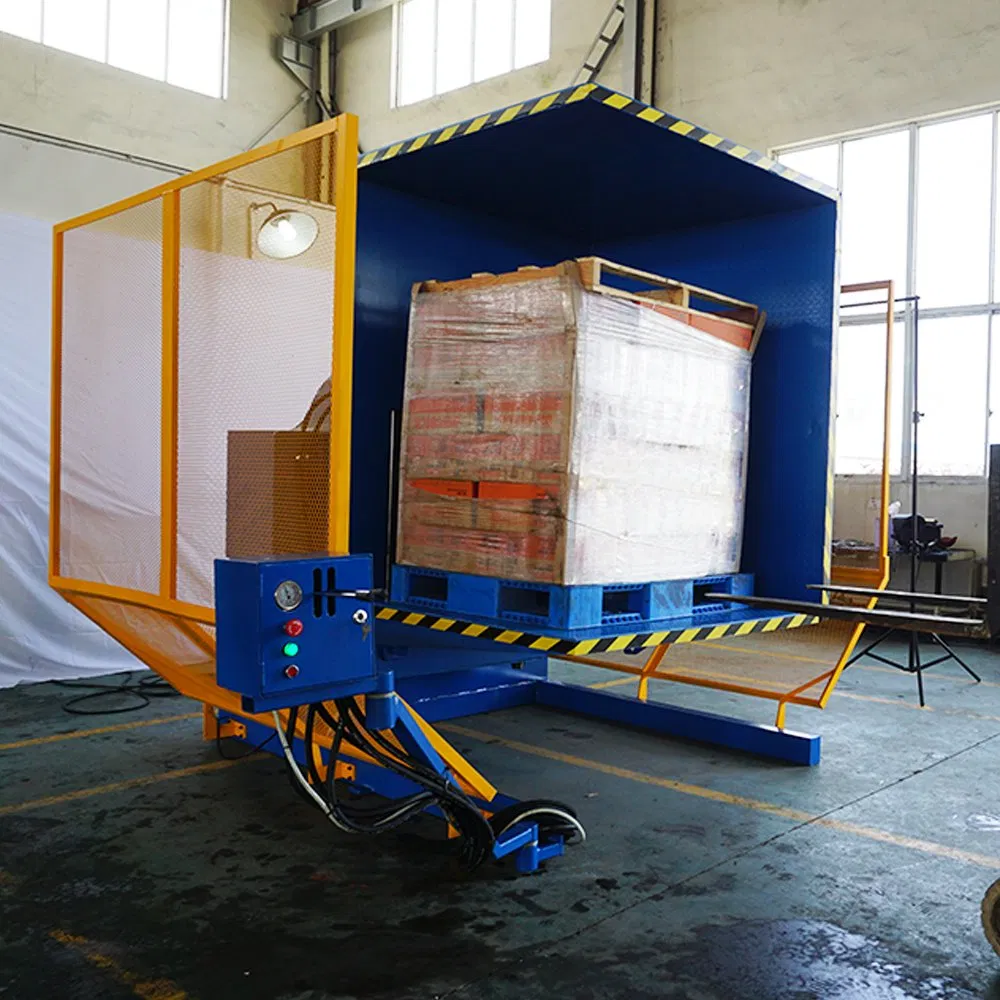Pallet Inverter Safety Tips for United Kingdom Plants Facing Brexit-ready pallet change compliance
Your United Kingdom plant is facing a new reality. The pressures of post-Brexit logistics mean every part of your operation needs to be faster, more efficient, and flawlessly compliant. You're likely dealing with new pallet regulations for shipping to the EU, creating a bottleneck in your warehouse. Manual pallet switching is slow, physically demanding, and a major safety risk for your team. You know there's a better way, but investing in new equipment like a pallet inverter brings its own set of worries about safety, training, and ensuring it solves the compliance problem instead of creating a new one.
For UK plants navigating post-Brexit logistics, ensuring pallet inverter safety is crucial for compliance. The key is to combine robust machine features with rigorous operational protocols. This means selecting inverters with comprehensive safety guards like light curtains and physical fencing, ensuring the machine can handle both standard UK pallets and EU-bound ISPM 15 compliant or plastic pallets without causing damage. Most importantly, it requires thorough operator training on safe loading, operation, and emergency procedures, all supported by a strict, documented maintenance schedule to guarantee both operator safety and uninterrupted, compliant trade.

I've seen this situation play out many times. As an engineer who has spent his life on factory floors, I understand that a machine is more than just steel and wires. It's a critical part of your production chain. The right equipment, used safely, can unlock new levels of efficiency. The wrong choice, or improper use, can lead to downtime, damaged goods, and—worst of all—injuries. Let’s walk through the essential safety considerations for a pallet inverter, so you can make a confident decision that protects your people and your business in this new era of UK trade.
What are the key safety features to look for in a Brexit-compliant pallet inverter?
You're considering a significant investment in a pallet inverter, and the number one question on your mind is, "Will it be safe for my team?" You worry that if you overlook a critical feature, you could be exposing your workers to unnecessary risk or buying a machine that doesn't fully meet the UK's stringent health and safety standards. This concern is valid. The right safety features are not just add-ons; they are fundamental to the machine's design and your peace of mind.
To ensure both safety and Brexit compliance, a pallet inverter must have a multi-layered safety system. Look for features like full-perimeter physical guarding or advanced light curtains to create a secure operating zone. Essential controls include easily accessible emergency stop buttons, dual-hand controls to keep the operator's hands clear during the cycle, and a robust hydraulic or electric clamping system with pressure sensors to prevent loads from shifting or falling. For Brexit-readiness, the machine must have adjustable clamping pressure to handle different pallet types, such as heat-treated wooden pallets (ISPM 15) or plastic pallets, without causing damage that could lead to a rejected shipment.

Dive Deeper: A Breakdown of Essential Safety and Compliance Features
When I help a client specify a new machine, I encourage them to think about safety on three levels: the machine itself, the operator's interaction with it, and the surrounding environment. This framework ensures no stone is left unturned.
Machine-Level Safety Features
This is the hardware, the built-in protection that forms the first line of defense. In the UK, this is governed by regulations like the Provision and Use of Work Equipment Regulations 1998 (PUWER), so non-compliance is not an option.
- Guarding: You have two primary options here. Physical fencing is the most robust solution, creating a locked cage around the inverter that prevents any physical access during operation. The access gate is interlocked, meaning the machine cannot start if the gate is open and will immediately stop if it's opened mid-cycle. The alternative is using light curtains, which are photoelectric sensors that create an invisible barrier. If a person or object breaks the beam, the machine stops instantly. Light curtains offer more flexibility for integration with conveyors but require rigorous testing to ensure they are functioning correctly.
- Clamping System: This is arguably the most critical safety feature. A failure here could lead to a tonne of product falling. The system, whether hydraulic or electric, must provide consistent and secure pressure. Look for machines with pressure relief valves to prevent over-pressurizing and potentially crushing your product. More advanced models have sensors that confirm the load is secure before the rotation cycle can begin.
- Controls: The control panel should be intuitive, but more importantly, safe. Dual-hand controls are a must for any semi-automatic operation. This design requires the operator to use both hands to initiate the cycle, ensuring their hands are far from any moving parts or pinch points. Emergency stop buttons should be prominent, numerous, and located at key points around the machine for instant access.
Brexit Compliance: The Pallet Handling Challenge
Brexit introduced a hard requirement for wooden pallets moving between the UK and the EU to be heat-treated and stamped according to ISPM 15 standards. This has led many companies to switch to plastic or presswood pallets for exports. Your pallet inverter must be able to adapt.
| Feature | Safety Benefit | Brexit Compliance Link |
|---|---|---|
| Adjustable Clamping Pressure | Prevents crushing of delicate products or packaging. | Allows safe handling of both robust wooden pallets and more fragile plastic/presswood pallets without causing damage. A damaged pallet, especially a cracked plastic one, could be rejected. |
| Wide & Flat Clamping Tables | Distributes pressure evenly across the load, ensuring stability. | Minimizes stress on ISPM 15 stamped wooden pallets, preventing cracks that could compromise their structural integrity and compliance. |
| Gentle Rotation Control | Smooth start and stop motion prevents sudden jolts that could shift the load. | Protects the goods during the transfer, ensuring the final palletized load is neat and stable for transport, meeting carrier and customs expectations. |
Choosing a machine with these features is the first step. It provides the foundation for a safe and compliant pallet changing process that can withstand the logistical demands of post-Brexit trade.
How can proper operator training reduce accidents with pallet inverters?
You've invested in a state-of-the-art pallet inverter with all the best safety features. But a machine is only a tool. You know that its safe and efficient use ultimately depends on the person operating it. You have a constant worry in the back of your mind: what if an operator gets complacent, tries a shortcut, or simply doesn't understand the machine's limits? An accident caused by human error could negate all your investment in safety hardware and lead to serious consequences for your employee and your operation.
Proper operator training is the single most effective way to reduce accidents. It transforms the pallet inverter from a potentially dangerous piece of heavy machinery into a predictable and safe asset. Effective training moves beyond just showing someone which buttons to press. It builds a deep understanding of the machine's mechanics, its limitations, potential hazards, and the correct procedures for every situation, including emergencies. This knowledge empowers operators to work confidently and safely, identifying potential issues before they become accidents.

Dive Deeper: Building a Culture of Safety Through Training
In my journey from engineer to factory owner, I learned a powerful lesson: you can't just "tell" someone to be safe. You have to build a system and a culture where safety is the easiest and most logical choice. For pallet inverters, this system is a comprehensive training and certification program. It's not a one-time event; it's an ongoing process.
I remember a client, a steel stockholder in the Midlands. Much like you, Javier, he was a sharp operator who understood the value of good equipment. He bought a top-of-the-line pallet inverter to handle heavy steel coils. Six months later, they had a near-miss. A new operator, trying to impress his supervisor with his speed, didn't check if the heavy coil was perfectly centered before starting the cycle. As the machine tilted, the off-balance load caused a massive jolt. The safety interlocks worked and the machine stopped, but it was a serious scare.
This incident became a turning point. We worked with them to develop a formal training program with a few key modules:
1. The 'Why' Behind the 'How' (Theory)
Before anyone touches the machine, they must understand it.
- Machine Anatomy: We walk them through every major component: the hydraulic power pack, the clamping mechanism, the rotation assembly, the control panel, and all safety devices (E-stops, light curtains, interlocks).
- Physics of the Load: We use simple diagrams to explain the center of gravity. They learn why an off-center load creates dangerous forces during rotation. This was the key lesson from their near-miss.
- Risk Assessment: We review the manufacturer's risk assessment and our own site-specific one. We talk openly about what could go wrong: pinch points, crush zones, hydraulic fluid injection, and falling loads.
2. Hands-On Competency (Practical)
This is where theory meets practice in a controlled environment.
- Pre-Use Checklist: Every operator must learn to perform a daily check. Is the area clear? Are guards in place? Any visible hydraulic leaks? Do the E-stops work? They sign off on this check before their first operation of the day.
- Safe Loading and Unloading: We practice with different load types—stable boxes, irregular shapes, heavy items. They learn how to position the pallet correctly and how to check that the clamps are applying even, secure pressure.
- Normal Operating Cycle: They run the machine through dozens of cycles under supervision until the process is second nature.
- Emergency Drills: We simulate failures. What do you do if a light curtain is triggered? How do you correctly power down and restart after an E-stop? What's the procedure for a hydraulic leak?
3. Certification and Re-training
No one operates the machine alone until they have been formally signed off by a trained supervisor. We also implemented a rule for annual refresher training and immediate re-training after any safety incident or near-miss. This ensures standards don't slip over time.
The result for my client? The operators became machine experts. They took pride in their work and their safety record. And, interestingly, their pallet-changing throughput actually increased. Confident, well-trained operators work more smoothly and efficiently than ones who are hesitant or trying to rush. This is a perfect example of how investing in safety directly supports your goal of improving productivity.
What are the most common pallet inverter hazards in a UK plant and how to mitigate them?
You understand the need for safety features and training, but you're a practical person. You want to know what the real-world risks are. What are the specific hazards that your team will face every day when using a pallet inverter in your busy plant? You're concerned about the "unknown unknowns"—the subtle dangers that aren't immediately obvious but can lead to serious accidents if not properly managed. Identifying these specific hazards is the first step to neutralizing them.
The most common pallet inverter hazards in a UK plant are crush and shear points created by the rotating mechanism, the risk of falling loads due to improper clamping or mechanical failure, and unexpected machine movement during maintenance or cleaning. These are mitigated through a robust 'safe system of work' that combines engineered controls like interlocked guarding, strict procedural rules for operators, and a comprehensive Lockout-Tagout (LOTO) program for all non-operational tasks.

Dive Deeper: A Practical Guide to Identifying and Mitigating Hazards
In every factory I've worked in or managed, the approach to safety is the same: first, you identify the enemy, then you create a plan to defeat it. Let's get specific and map out the hazards of a pallet inverter and the concrete steps you can take, keeping UK regulations like the Health and Safety at Work etc. Act 1974 in mind. This is about creating a workplace that is not just compliant, but genuinely safe.
Hazard Hotspot Mapping
We can categorize the primary dangers to make them easier to manage. This is a process every plant manager should go through.
-
Mechanical Hazards: These are the most obvious risks from moving parts.
- Crush & Shear Points: The biggest danger zone is the area between the moving clamp/table and the stationary frame of the machine during the 180-degree rotation. Anything or anyone in that path is at risk.
- Entanglement: Any exposed rotating shafts or drive mechanisms could potentially snag loose clothing or hair.
- Falling Loads: This is a critical hazard. It can be caused by operator error (improperly positioned or unsecured load), hydraulic failure (loss of clamping pressure), or trying to lift a load that is too heavy for the machine's capacity.
-
Non-Mechanical Hazards: These are less obvious but equally dangerous.
- Hydraulic Hazards: Most pallet inverters use a hydraulic system operating at very high pressure. A pinhole leak in a hose can inject hydraulic fluid into a person's skin, causing a severe injury that requires immediate medical attention. A burst hose can spray hot oil and cause the load to be dropped.
- Electrical Hazards: The control panel and motors carry a risk of electric shock, especially during maintenance if the power is not correctly isolated.
- Noise Hazards: While not as acute, the hydraulic power pack can generate significant noise, potentially exceeding safe levels over an 8-hour shift, requiring hearing protection.
The Mitigation Matrix
Now, let's create a clear plan. For every hazard, there is a corresponding control measure.
| Hazard | Location / Cause | Mitigation Strategy | UK Regulatory Link |
|---|---|---|---|
| Crushing & Shearing | During machine rotation | Engineered Control: Install fixed guarding with interlocked gates or light curtains. Procedural Control: Mark a clear exclusion zone on the floor around the machine. Train operators to never enter this zone during operation. | PUWER Reg 11 |
| Falling Load | Clamping tables | Engineered Control: Use an inverter with a pressure-sensing interlock that prevents rotation if the clamp pressure is too low. Procedural Control: Strict training on load centering and weight limits. Daily visual inspection of clamp faces. | PUWER Reg 5, 6 |
| Hydraulic Fluid Injection | Hydraulic hoses and fittings | Maintenance Control: Implement a regular hose inspection schedule. Replace hoses based on age, not just on visible wear. Procedural Control: Train staff to never use their hands to check for leaks; use a piece of cardboard instead. | PUWER Reg 5 |
| Unexpected Movement | During maintenance/cleaning | Procedural Control: Implement a strict Lockout-Tagout (LOTO) procedure. The machine must be de-energized, and all power sources (electrical, hydraulic) locked off by the person working on it. | PUWER Reg 19 |
By systematically identifying each potential hazard and implementing a specific, multi-layered mitigation strategy, you are not just ticking a compliance box. You are building a resilient safety system that actively protects your people. This is the hallmark of a forward-thinking and well-run operation.
How does regular maintenance ensure both safety and Brexit-ready compliance?
You see maintenance on the schedule and sometimes it feels like a necessary evil—an activity that stops production and costs money. It's tempting to postpone a check-up when you're under pressure to meet a large order. You might ask yourself, "The machine is working fine, can't this wait?" This is a dangerous trap. You know deep down that a small, ignored issue like a worn hydraulic hose or a faulty sensor can escalate into a major failure, causing extended downtime and, more critically, a serious safety incident.
Regular, proactive maintenance is fundamental to ensuring both safety and Brexit-ready compliance. On the safety front, it prevents the catastrophic failure of critical components—like a hydraulic clamp or a safety interlock—that could lead directly to an accident. For Brexit compliance, a well-maintained machine operates reliably and handles pallets gently. This prevents damage to goods or ISPM 15-compliant wooden pallets, ensuring your shipments are not rejected at the EU border due to poor packaging quality or non-compliant, damaged pallets.

Dive Deeper: Maintenance as a Strategic Investment
I want you to stop thinking of maintenance as a cost and start seeing it as an investment in uptime and compliance. This shift in mindset is something I've seen in all the most successful factory owners I've worked with, like you, Javier. Your goal to increase equipment uptime to 95% is directly tied to a proactive maintenance strategy, not a reactive one. A machine that is cared for is a machine that you can count on.
Let's move beyond the abstract and build a practical maintenance framework. This is the kind of schedule we help our clients implement. It’s structured to catch problems early, long before they affect production or safety.
A Multi-Tiered Maintenance Schedule
A robust plan involves different people with different frequencies.
-
Tier 1: Daily Operator Checks (5 Minutes)
- Who: The machine operator.
- What: A simple, visual pre-start check.
- Area Scan: Is the floor around the machine clear of debris or oil?
- Guard Check: Are all physical guards in place and undamaged?
- Visual Leak Check: Any drips from hydraulic hoses or fittings?
- E-Stop Test: Press an emergency stop to ensure it cuts power.
- Why: This empowers the operator to take ownership of their equipment and catches the most common day-to-day issues.
-
Tier 2: Weekly Maintenance Checks (30 Minutes)
- Who: A trained maintenance technician.
- What: A more hands-on inspection.
- Clean Sensors: Wipe down photoelectric sensors for light curtains to ensure reliability.
- Check Hydraulic Fluid Level: Top up if necessary.
- Test All Interlocks: Manually check that opening the gate stops the machine.
- Listen for Unusual Noises: Run a cycle and listen for any grinding or whining from the motor or bearings.
- Why: This prevents the gradual degradation of safety systems and fluid levels.
-
Tier 3: Quarterly/Annual Professional Service
- Who: Your in-house expert or the OEM's service engineer.
- What: A deep dive into the machine's health.
- Hydraulic System Health Check: Test fluid pressure and quality. Inspect all hoses for signs of abrasion, cracking, or blistering. Replace hoses based on the manufacturer's recommended lifespan, not just on visible failure.
- Structural Integrity: Check all welds and tighten structural bolts to the correct torque.
- Electrical System: Inspect wiring in the control cabinet for any loose connections or signs of overheating.
- Why: This is predictive maintenance. It finds and fixes major problems before they happen, preventing catastrophic failure and unplanned downtime.
The Critical Link to Brexit Compliance
This is where maintenance directly impacts your ability to trade smoothly with the EU.
- Protecting Pallet Integrity: A poorly maintained hydraulic system can cause jerky movements or apply incorrect pressure. This can easily crack or splinter an ISPM 15 stamped wooden pallet. A customs official seeing a damaged pallet may question its integrity and reject the entire shipment.
- Preventing Product Damage: A smooth, reliable machine packs a neat, stable load. A machine that jolts can cause products to shift, damaging packaging. Damaged goods are a red flag for customs and lead to costly returns.
- Ensuring Dispatch Reliability: Post-Brexit logistics often rely on meeting tight deadlines for ferry or tunnel crossings. An unexpected machine breakdown in your dispatch area can cause you to miss your slot, leading to delays, extra charges, and unhappy customers. Reliable equipment, guaranteed by good maintenance, is essential for a predictable supply chain.
By investing in a structured maintenance program, you are directly supporting your core business goals: improving uptime, ensuring safety, and securing your vital trade routes into the European market.
My Insight
Javier, when I read your profile, it felt very familiar. You are a leader who has risen through the ranks. You understand the details of mechanical engineering but also the pressures of the balance sheet. Your challenges—volatile energy costs, aging equipment, intense environmental and market pressures—are the very issues I've dedicated my career to solving, first for my own factory and now for my clients.
I started my journey on the factory floor. I know the satisfaction of a production line running perfectly, and I also know the gut-wrenching feeling of silence when a critical machine goes down. That experience taught me something profound: equipment like a pallet inverter isn't just a line item in a capital budget. It's the heart of a process. And its safety is not just about meeting regulations; it's about reliability and profitability.
When we discuss the safety tips for a pallet inverter in a UK plant, we are really talking about your core goals.
- Goal #1: Increase Capacity Utilization. A safe machine is a reliable machine. The training and maintenance we've discussed are the foundation of predictive maintenance, preventing the unplanned downtime that kills utilization rates. A confident, well-trained operator works more efficiently, contributing directly to that 95% target.
- Goal #4: Improve Profit Margin. Every pallet change that results in damaged product is a direct hit to your bottom line. Every near-miss or accident has hidden costs in investigation time and lost morale. Ensuring the inverter handles pallets correctly—especially for Brexit compliance—prevents costly rejected shipments and protects your margin.
- Challenge #2: Aging Equipment. Introducing a new, safe, and efficient pallet inverter isn't just replacing an old machine. It's an opportunity to re-think the entire workflow, possibly integrating with conveyors to reduce forklift use, which addresses your energy cost challenge (Challenge #1).
You are looking for a strategic partner, not just a supplier. A partner understands that the 'Total Solution' isn't just about selling you a machine. It's about understanding your specific challenges in the steel industry and providing a solution that addresses them. It’s about offering expertise on how to integrate that machine into your digital transformation plans, perhaps with sensors that feed data into your MES platform. At SHJLPACK, this is the philosophy that drives us. It comes from my own gratitude for what this industry has given me, and a genuine desire to see leaders like you succeed.
Conclusion
Prioritizing pallet inverter safety through smart features, rigorous training, and proactive maintenance is not a burden. It is a direct, strategic investment in your plant's uptime, profitability, and future-proof compliance.




